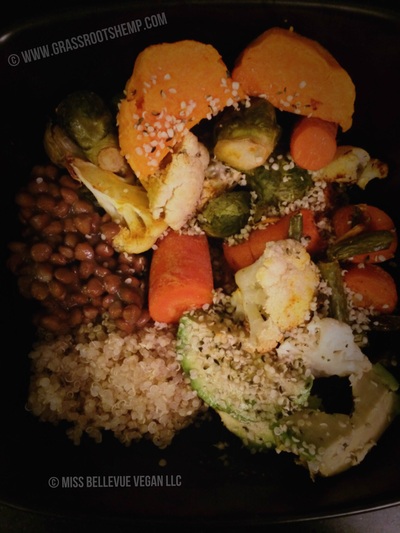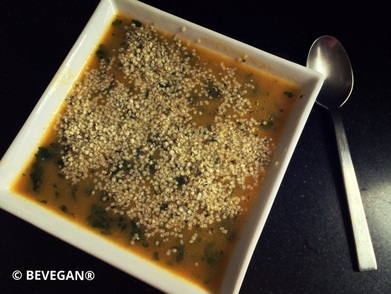How Plant-Based Nutrition Fuels Peak Performance |
| I’ve been a vegan for many years – back to when a vegan lifestyle was only for earth-loving hippies. Veganism has gained popularity over the past ten years or so. There is more awareness and education around the effects that factory farming has on our planet, as well as what’s going on with over-consumption and mass production. A lot has changed. Science is now supporting plant-based diets for optimal health, and Veganism has even been gaining popularity among athletes. As a vegan athlete myself, I often get asked common questions, such as: “How are you not anemic? How come you never get sick? Where do you get your protein? How do you have enough energy to run as much as you do?” I love this dialogue and being an example that contradicts the misconceptions that a plant-based diet can improve strength, performance and overall health. |
The Fueling Phases: Before, During, and After
The most important factor is digestibility and food requires energy to digest. Since energy is vital, you want to have control with how you spend it. Many foods take large amounts of energy to digest, so choose foods that are high in net gain. Net gain refers to the useable nutrition the body is left with once the food is digested and assimilated. If food hasn’t been digested completely, you can cramp easily. Proper plant-based nutrition will provide you with a solid eating plan loaded with foods that are high in net gain.
Consume food providing a combination of complex carbs, fats, and proteins. A great choice includes DIY Superfood Cereal (recipe below). Be sure to also hydrate with 16-32 oz. of water.
| Ingredients: 3/4 cup buckwheat groats 3/4 cup chia seeds 3/4 cup hemp seeds 1/2 cup raisins 1/2 cup dried or dehydrated apples, finely chopped 1/2 cup walnuts 1 teaspoon cinnamon Directions: Add everything together, stir, and store in airtight jar. When ready to enjoy, add 1/4 cup to bowl and pour about 1/3 cup plant-based milk of choice, and let sit for 3-5 minutes to soften. Top with pumpkin seeds and fresh fruit of choice if you’d like. Enjoy! |
Never allow yourself to become hungry or thirsty. If you can tackle this, you will be a true, performing rock star. Nutrition during prolonged activity requires the proper mix and timing. For example, too little fluid or the wrong carbohydrates can result in cramping and other intestinal problems you would rather not experience.
Fuel your body with clean, plant-based foods that are easy to digest. Be sure to include fats, proteins, and carbohydrate-rich choices. Protein will complement the carbohydrate, allowing it to enter the bloodstream at a steady rate, thus delaying the onset of hunger and sustaining energy levels. Much of the real energy comes from carbs and fat. Fat is the longer-lasting energy source and is needed most during endurance activities. Fat also supports brain health, helps maintain body warmth, keeps the joints lubricated, aids in recovery and minimizes the inflammatory processes.
| Some great choices include:
Also, opt for energy bars that are unprocessed, vegan and have naturally occurring vitamins, minerals, and nutrients, such as Amrita. Tip for keeping superfoods stocked at home for cost-effective convenience include: Buy bulk and store in mason jars. |
Also, hydrate often and keep electrolytes balanced. Sweat consists of water and electrolytes (salts). Simply replenishing water without also replenishing electrolytes can create imbalances and even lead to water intoxication. Milder symptoms include cramping and muscle twitches and even blacking out. Be mindful on what you drink though, as many sports drinks are unfortunately just flavored sugar water containing artificial ingredients and colors loaded with refined sugar. Coconut water is an excellent, natural choice and can even be used as a base to make your own homemade concoctions. Some additional easy-to-pack electrolytes include bananas, sea salt, and individually packed replenishers, such as Vega Sport Electrolyte Hydrator, Nuun tablets, and Ultima Replenisher.
Within 20 minutes of completing your long-duration adventure, the body needs simple carbs to enter the bloodstream. This means your snack choice should contain minimal fat and protein and no fiber, since these slow the rate at which carbs enter the bloodstream. A 4:1 ratio of carbs to protein is most effective, as it will speed up glycogen replenishment (rate at which muscles absorb carb). Great choices include a recovery drink, or other near-liquid-consistency foods such as smoothies or puddings. These are much easier to digest, therefore requiring less energy. Hemp and chia seeds are excellent choices. You can equally use a small amount of hemp oil too as it will help repair soft-tissue damage.
| About 1 hour past, a nutrient-rich meal is best. If possible, opt for choices that include plant-based, easily digestible protein and healthy Omega-3s, such as hemp and chia seeds. An example would be a high protein salad with lots of fibrous veggies, high protein seeds, pseudograins and legumes like quinoa, peas, lentils, spirulina and pumpkin seeds. A healthy dressing to use is hemp/flax oil, sea salt, ground pepper and garlic. |
| INGREDIENTS 1 tbsp. organic coconut oil, melted 1 tsp. dried rosemary 2 tsps. mustard seeds ½ tsp. salt ½ tsp. black pepper 2 cloves garlic, diced ¼ cup hemp seeds ¼ cup walnuts Lemon zest from one lemon |
INSTRUCTIONS
1. Preheat oven to roast at 400°F (205°C)
2. Clean and trim green beans.
3. Place green beans in a baking dish.
4. Drizzle with melted coconut oil.
5. Sprinkle with rosemary, mustard seeds, garlic salt, and pepper.
6. Toss and mix to ensure the green beans are evenly coated in oil and spices.
7. Roast at 400°F (205°C) for 30-35 minutes, or until all the green beans are crispy.
8. Stir green beans half way through cooking.
9. Remove from oven; add hemp seeds and walnuts. Toss well.
10. Sprinkle with lemon zest and serve.
NOTES
Serve with wild rice or quinoa for a complete, plant-based meal.
#Hemp Provides Steady Nourishment for Activities
Key Point: You’ll be minimizing the energy wasted in the digestion process. (Fuel on unrefined, unprocessed foods)
If you fuel efficiently, you’ll be easing digestive strain, and you will have a consistent level of energy across the entire day of hiking peaks and valleys.
| INGREDIENTS 1-2 tbsp. coconut oil 1 medium onion, sliced thin 2 cups of fresh kale, chopped 1 tbsp. fresh ginger, minced 2 garlic cloves, minced 2 tbsp. curry powder 1/2 tsp. coriander 1/8 tsp. cayenne pepper 1 tsp. cumin powder 2 15-ounce cans canned organic pumpkin 6 cups vegetable broth 2 cups coconut milk (full fat) 1 tbsp. agave nectar or coconut nectar Salt to taste 8-10 tbsp. of hemp seeds |
1. In a large pot, heat coconut oil over medium-high heat. Add onions, fresh kale and garlic; sauté for about 5 minutes.
2. Add the curry powder, coriander, cumin, cayenne pepper and salt; stir well for 1 minute.
3. Add vegetable broth and bring mixture to boil. Reduce heat to low and simmer, covered for about 10 minutes.
4. Add pumpkin, coconut milk and nectar, stirring well.
5. Transfer mixture to blender/food processor and process until creamy.
6. Return soup to pot and cook over medium heat until desired temperature and consistency.
7. Serve topped with 1-2 tablespoon of hemp seeds and enjoy!
BEVEGAN® Vegucation:
- Kale is full of flavonoids. These, combine both antioxidant and anti-inflammatory benefits in way that gives kale a leading dietary role with respect to avoidance of chronic inflammation and oxidative stress.
- Kale belongs to the same family as cabbage, Brussels sprouts, and collards.
- Kale is recognized as providing comprehensive support for the body's detoxification system.
- Coconuts are highly nutritious and rich in fibre, vitamins C, E, B1, B3, B5 and B6 and minerals including iron, selenium, sodium, calcium, magnesium and phosphorous.
- Pumpkin is rich in fiber, which slows digestion
- Pumpkin is packed with nearly 20 percent of the recommended amount of daily vitamin C, which may help you recover from colds faster.
- Pumpkin has been shown to reduce blood glucose levels, improve glucose tolerance and increase the amount of insulin the body produces.
- Pumpkin's brilliant orange coloring comes from its supply of beta-carotene, which is converted to vitamin A in the body. A fantastic option for optical health.
- Hemp seeds are packed with easily digestible proteins and contain all 10 essential amino acids, putting them among the rare plant-based foods that provide complete protein.
- Hemp seeds are abundant in omega-3 fatty acids, as well as a specific omega-6 fatty acid (GLA) not found in any other food; hemp oil contains even more GLA.
- Hemp seeds are high in fiber and rich in minerals including magnesium, iron, zinc, and potassium. Hemp seeds are very rarely allergens, unlike many other nuts and seeds
Kristin Wuhrman
Owner of BEVEGAN® Grassroots Health. Board Certified Holistic Health Coach. AKA Miss Bellevue Vegan. Plant-Based Health Consultant. Vegan Athlete. Outdoor Enthusiast. Outdoor Gear Reviewer. Author. Cotopaxi Local Ambassador. Animal Lover. Dreamer. Believer.
Categories
All
BEVEGAN Active
BEVEGAN Life
Blurbs
Cotopaxi
Grassroots Hemp Recipes
Guest Blog Posts
Health
Plant Based Eating
Product Reviews
Vegan Athlete Interviews
Veganism
Vegan Recipes
Archives
September 2017
November 2016
October 2016
September 2016
June 2016
May 2016
March 2016
February 2016
January 2016
December 2015
November 2015
October 2015
September 2015
August 2015
July 2015
June 2015
May 2015
April 2015
March 2015
February 2015
January 2015
December 2014
November 2014
October 2014
September 2014
August 2014
June 2014
April 2014






















